Carl-Gustaf Rossby: Theorist, institution builder, bon vivant
DOI: 10.1063/PT.3.3428
Carl-Gustaf Arvid Rossby was a gregarious, high-spirited powerhouse in the world of meteorology. Wherever the man went—and he went far during a nearly 40-year career—he was at the center of a moving seminar on atmospheres and oceans, surrounded by his many colleagues, nurturing a cadre of elite students, and holding court at the best dining and drinking establishments in town.
Rossby got his start in meteorology under fluid dynamicist Vilhelm Bjerknes and worked to bring Norwegian methods of air-mass analysis to the US. He soon developed his own school of thought and brought to the study of meteorology and dynamic oceanography novel analysis techniques and influential theories about the behavior of upper-air winds and ocean currents. He benefited from and further developed airplane and radio-balloon soundings, rotating-tank experiments, and other technologies—especially digital computing.
Rossby traveled the world promoting international understanding and cooperation in meteorology. His “centers of action” included the Forecasting Division of Western Norway, the Swedish Meteorological and Hydrological Institute, the US Weather Bureau, the Daniel Guggenheim Fund for the Promotion of Aeronautics, MIT, the Woods Hole Oceanographic Institution, the University Meteorology Committee, the University of Chicago, the American Meteorological Society, the Institute for Advanced Study in New Jersey, the International Meteorological Institute in Stockholm, and the US National Academy of Sciences. In 1956 Time magazine featured Rossby on its cover and profiled him in its pages, writing, “The history of modern meteorology is inescapably paralleled by Rossby’s career… . Most leaders of modern meteorology are friends or past pupils of Dr. Rossby’s.” That statement is basically true; most active atmospheric scientists trace their academic lineage back to Rossby. Yet there is much more for readers to learn about him.
Education of an apprentice
Rossby was born on 28 December 1898 in Stockholm, the first of five children of Arvid Rossby, a construction engineer, and Alma Charlotta Marelius Rossby. By all accounts, he was cultured, quick-witted, and excitable, with diverse interests in music, geology, botany, and especially the orchids that grew in abundance on the island of Gotland, his mother’s ancestral home. He was an excellent and conscientious student who studied at Högskola (literally high school, but referring to the former name of Stockholm University), where in 1918 he earned a degree of filosofie kandidat (the equivalent of a bachelor’s degree), with mathematics, mechanics, and astronomy as his major subjects.
In 1919 Rossby attended a lecture by Bjerknes on moving discontinuities in the atmosphere and later applied for a position as his research assistant. Rossby said he wanted to spend a summer vacation in Norway anyway. Bjerknes had developed a fundamental “circulation theorem” that described the dynamics of the atmosphere and ocean from first principles. It could explain land and sea breezes, mountain and valley winds, and, qualitatively, cyclones and anticyclones as boundary phenomena propagating between cold and warm air moving in the general circulation. But Bjerknes also understood that perfect prediction of the weather was unattainable. For him, meteorology was a Gordian knot: an intractable and intertwined tangle of observational imprecision, theoretical uncertainties, and nonlinear forces. He strove to attain a sufficiently accurate knowledge of the state of the atmosphere at a certain time and a sufficiently accurate knowledge of the laws according to which one state of the atmosphere develops from another, so that he could make a sufficiently accurate forecast.
Bjerknes improved techniques for measuring the atmosphere and, with his junior colleagues, established the Bergen school of meteorology, which promoted the polar-front theory of cyclones (see the
Rossby joined the Bergen school on 20 June 1919. He arrived as an inquisitive 20-year-old student with no prior knowledge of the atmosphere, and he readily mastered the key theoretical aspects of dynamic meteorology and the forecasting techniques then under development. He was full of helpful practical suggestions, such as revising the color scheme for fronts on weather maps, launching experimental sounding balloons, and organizing teams of forecasters. His strong suits were identifying fundamental issues, generating new theoretical ideas, and mobilizing people around him. He was organized and persuasive, a skillful weather-map analyst, a natural orator, and a natural leader.
In 1921 Rossby accompanied Bjerknes to Leipzig, Germany, for a year of advanced study at the Geophysical Institute and gained experience launching instrumented kites and balloons at the Prussian Aeronautisches Observatorium in Lindenberg. He was seeking connections between theory and observations of the upper atmosphere. In his first scientific publication, Rossby proposed a farsighted if somewhat impractical program to establish a network of aerological stations around the Norwegian Sea and as far northwest as Greenland. At the time, weather maps were typically of limited geographical extent, and observations of upper-airflow patterns were almost nonexistent.
Rossby spent the summer of 1922 in Bergen, Norway, before returning to Stockholm, where he worked for three years at the Swedish Meteorological and Hydrological Institute (SMHA) as a junior meteorologist under the direction of Johan Sandström. At the same time, he continued his studies in mathematical physics with the celebrated mathematician Erik Ivar Fredholm and earned the degree of filosofie licentiat (the equivalent of a PhD sans dissertation) in 1925. During the course of his studies, Rossby served as the meteorologist on board several scientific cruises. In 1923, he sailed to Greenland on the Conrad Holmboe to establish weather stations for the Bergen school and to collect oceanographic and meteorological data. The ship barely escaped disaster when it was caught in pack ice near eastern Greenland for six weeks; it suffered such heavy damage that it eventually had to be scuttled.
In 1924 the SMHA assigned Rossby to the Royal Swedish training ship af Chapman on its voyage around the British Isles. His duties included preparing weather forecasts and taking upper-air observations. Some have said Rossby never took his own observations, but he certainly did so on that voyage. He collected and decoded weather information sent by official and amateur observers via wireless radio, a process he found “hopelessly confusing.” To supplement that information, he used his own observations of wind, cloud formations, and differences in temperature between the air and ocean surface to prepare forecasts according to Bergen-school methods.
To investigate atmospheric winds, Rossby launched pilot balloons and tracked them with a special theodolite, a tripod-mounted telescope for the precise measurement of angles, stabilized to function properly on the rolling deck of the ship. By charting the results of nine ascents, he was able to estimate surface wind stresses and calculate the dissipation and vertical transport of heat in the atmosphere at different heights above the sea surface. On 10–11 August 1924, with the ship pounded by heavy weather and veering dangerously close to the Irish coast, a seriously seasick Rossby issued a critical—and correct—forecast for turning winds that would put them back on course. The following year he set sail once again as the meteorologist on a voyage to Portugal and Madeira.
Bjerknes may have steered Rossby into a career in meteorology, but he did not capture Rossby’s sole allegiance. Neither did the routine work of the SMHA. He had bigger plans.
Tanks and balloons
Rossby won an American–Scandinavian Foundation fellowship for 1926 that brought him to the US Weather Bureau in Washington, DC, “to study dynamic meteorology problems.” One of his goals was to demonstrate the applicability of polar-front theory to American weather. Yet Rossby was not simply an acolyte for the Bergen school. Like Bjerknes, he was very much his own man—a fluid dynamicist with big theoretical ideas, an intuitive and innovative thinker, and a builder of institutions. During an active first year in the US, he studied convection and turbulence, consulted on aviation safety, and reanalyzed US weather maps using polar-front theory.
His first project was to construct a rotating-tank experiment, shown in figure 1, in the basement of the weather bureau in order to simulate the atmosphere. The project was inspired by Hermann von Helmholtz’s hydrodynamical theory of vortex motions and informed by a rotating-dishpan experiment described by Felix Exner in 1925. Rossby’s tank was 2 m in diameter and was filled with melted paraffin. It was differentially heated, like Earth’s atmosphere, and rotated slowly around a vertical axis. Also like the atmosphere, the tank had large horizontal dimension compared with its vertical depth and was thus, to first approximation, two-dimensional. When the heat was removed and the paraffin solidified, it revealed dynamic features of the circulation.

Figure 1. Carl-Gustaf Rossby stands next to his first rotating wave tank, built in 1926 and used to simulate atmospheric motion. Two meters in diameter, differentially heated, and filled with colored paraffin waxes of different densities, the tank rotated around a vertical axis three to four times per minute. When the paraffin solidified, it preserved dynamical features produced during the rotation. (Courtesy of the National Oceanic and Atmospheric Administration.)
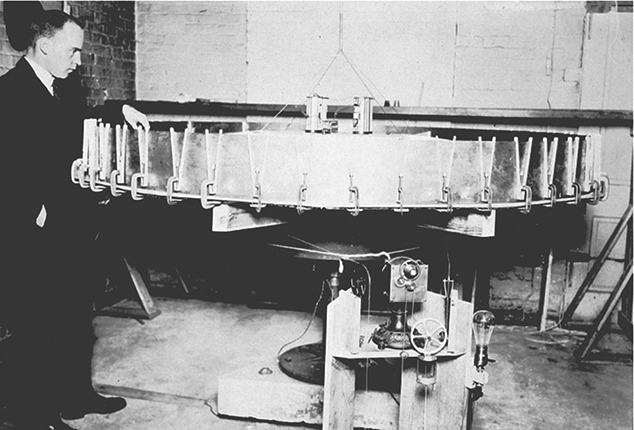
Such simplification was the key to Rossby’s approach to science. Although the tank suffered mechanical failure and his initial attempts to simulate the atmosphere and write nondimensional equations of its motion were inconclusive, Rossby persisted, and some two decades later that line of research eventually proved fruitful.
Rossby and weather bureau forecaster Richard Weightman published two articles on polar-front theory that analyzed the development of weather conditions over several days. They concluded that a denser observation network was needed to forecast reliably the positions and the energies of storms, but they also argued that polar-front theory had given them an advantage over existing tools in explaining complex phenomena and their underlying dynamics. After his fellowship year, Rossby established a model aviation forecasting system in California in 1927 for the Daniel Guggenheim Foundation and in 1928 moved to MIT, where he initiated the first graduate program in meteorology and instituted a program of joint seminars and collaboration with oceanographers at Woods Hole in 1930. The following year he was poised for yet another innovation in forecasting weather—not from the surface but from an altitude of 5.5 km.
MIT purchased a research airplane in 1931 to carry aloft a device that traced a continuous record of temperature, relative humidity, and barometric pressure on a rolling paper chart. Rossby used the measurements to identify dynamic features of the upper atmosphere. Although the combination of strong winds and icing on the wings often made flying much too dangerous even for experienced pilots, it was just such severe weather that was most disruptive to society and thus of most interest to meteorologists. In 1936 a new remote-sensing device became available that superseded piloted-aircraft soundings. Known as the radiosonde, the new device used an expendable meteorological instrument package, borne aloft by a free-flight balloon as shown in figure 2, to measure the vertical profiles, from surface to stratosphere, of atmospheric variables and to transmit the data via radio to a ground receiving system. According to Rossby, communications are the alpha and omega of meteorology, and in the late 1930s the radio “robot observers” became increasingly common.

Figure 2. A radiosonde ready to be launched, circa 1940. The expendable instrument package, attached to a sounding balloon, measured the vertical profiles of atmospheric variables such as temperature, pressure, and humidity as the balloon rose from the surface to the stratosphere. Along the way, a radio transmitter in the package sent the data to a ground receiver. (Image from the National Archives and Records Administration RG-27, MD 27-G-10-16-1.)
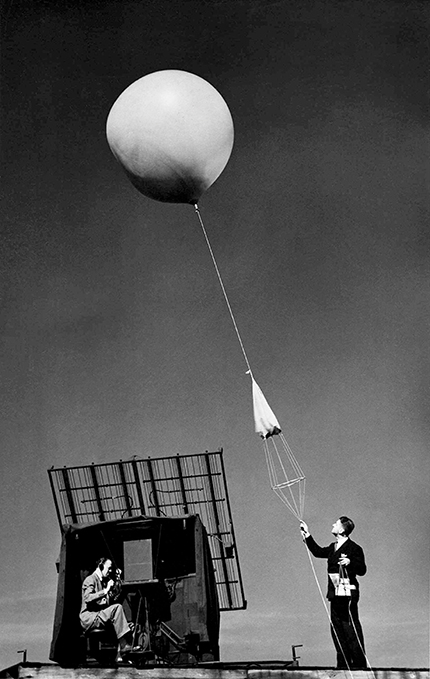
Helium-filled balloons could fly to an altitude of 12 km—much higher than piloted aircraft—and could be launched in virtually all weather conditions with no risks to aviators. Meteorologists quickly adopted radiosondes for daily weather soundings, which immediately expanded the observational height of the atmosphere. Because a radio-receiving ground station became part of every radiosonde launch, Rossby added courses in electronics to the meteorological training at MIT. He ordered enough radiosondes (300 in all) to supply a network of 10 stations in New England for an experimental project lasting a month. He encouraged the weather bureau to begin a national network of twice-daily balloon launches. Eventually those launches numbered 200 per day. He used their measurements to identify large-scale flow patterns in the upper atmosphere that have a direct influence on surface weather. Identifying those waves, which are now named after him, was perhaps Rossby’s most important scientific discovery.
Planetary waves
The atmosphere is filled with waves of various frequencies and amplitudes—short, shock, lee, mountain, Helmholtz, frontal, and cyclone waves, along with thermal atmospheric tides—often made visible by cloud forms. (For an image of atmospheric gravity waves, see Back Scatter, Physics Today, June 2006, page 96
Planetary waves have wavelengths on the order of 5000 km, with typically four or five ridges and troughs at any one time encircling the planet at or above the 40th parallel (see figure 3). They mark the boundary between cold polar air and warm tropical air and define the location of the polar-front jet stream. For Rossby, the research frontier circulated high in the atmosphere. But because the waves’ vertical extent is only about 20 km, the waves effectively behave as 2D inertial fluid systems. And they may be effectively studied by atmospheric observations, which were the basis of figure 3, or by experiments in rotating tanks.

Figure 3. Planetary-wave pattern. In this circumpolar northern-hemispheric representation of the upper atmosphere’s measured temperature distribution, the air circulation is characterized by a well-developed pattern of five lobes—the periodic northern and southern excursions of the high-altitude winds circling the planet. Solid and dashed lines represent isotherms drawn at intervals of 5 °C. Larger temperature intervals are marked by shading, with darker shading representing colder air. The red solid and dashed lines indicate the positions of the strongest wind belts, today referred to as jet streams. Dashed-line segments are regions of greater uncertainty. (Adapted from B. Bolin, ed., The Atmosphere and the Sea in Motion: Scientific Contributions to the Rossby Memorial Volume, Rockefeller Institute Press, 1959, p. 20.)
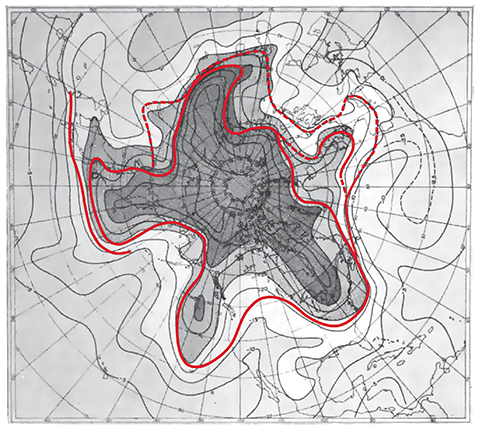
More institution building
By 1939 Rossby was well on his way to establishing a new school of meteorology. His so-called Chicago school was grounded in the theoretical foundations of Bjerknes and the practical techniques of the Bergen school. But it transcended Bergen techniques, going beyond the polar-front concept to emphasize hemispheric flows, planetary waves, and ultimately jet-stream meteorology.
Naturalized that year, Rossby served his adopted country well. He supervised the instruction of thousands of weather cadets during World War II. He was a mentor and role model to those who studied under him and an inspiration and unforgettable colleague to his peers. He established the University of Chicago’s department of meteorology and the University of Puerto Rico’s Institute of Tropical Meteorology. He worked to professionalize the American Meteorological Society during his 1944–45 tenure as president and founded the Journal of Meteorology in 1944. He advanced the cause of numerical weather prediction at the Institute for Advanced Study by recruiting leading scientists to the cause.
American meteorologist Jule Charney once remarked that the Rossby formula for the propagation speed of long waves in a barotropic atmosphere, one whose density is a function only of pressure, opened the door for numerical weather prediction. Indeed, it was the upper-air frictionless flow patterns, not the far more complicated weather conditions closer to the surface, that the first computer models were able to predict in the early 1950s.
In 1947 Rossby returned to his native Sweden, where he established at Stockholm’s International Meteorological Institute a world-class research group that studied numerical weather prediction, atmospheric chemistry, and climate dynamics (see figure 4). The institute later served as an inspirational model for the US National Center for Atmospheric Research. He also founded the international geophysical journal Tellus (Latin for “Earth”). Acutely aware of the pressing needs and opportunities in the postwar era, Rossby called on scientists from former enemy nations to cooperate with each other and support international research projects. Rossby pursued numerical weather prediction in Sweden in an era in which there was no Swedish word for digital computer. He supported the world’s first operational numerical forecast, which was generated by the BESK (Binary Electronic Sequence Calculator), while staying abreast of parallel developments in the US.

Figure 4. Rossby in Stockholm, 6 October 1954. While he lived in Stockholm, Rossby was happily building the International Meteorological Institute. (Courtesy of Susan Wexler Schneider.)
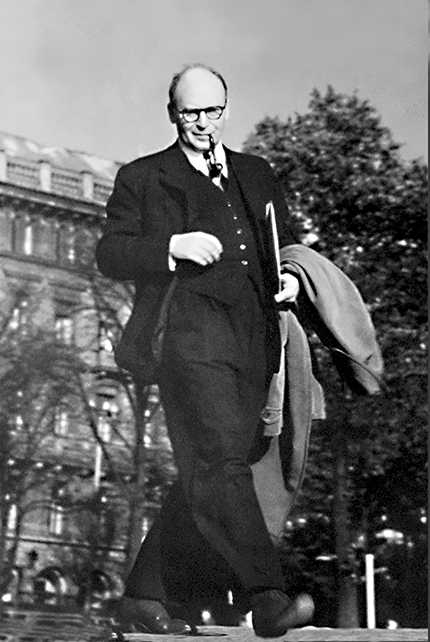
Rossby continued a lifelong connection with Woods Hole while maintaining both a residence and a research professorship at Chicago through 1951. Chester Newton, a former student at Chicago, recalled, “When Rossby was in town, the department was in tumult. There were interesting people coming by, there were things happening every day, and—it was exciting but exhausting.” At a meeting of the National Academy of Sciences Committee on Meteorology in 1956, Rossby suggested that the definition of meteorology be enlarged to include the role of the atmosphere not simply as an environment but as a milieu that directly influences all human experience. He called for scientists from other fields to work together on specific problems and to take advantage of new techniques, challenges, and opportunities on the immediate horizon.
Within two years the committee expanded its core membership to include mathematicians, chemists, atomic physicists, and space scientists. Since that time, atmospheric science has become an umbrella term covering the explosion of research specialties in meteorology, climatology, cloud physics, atmospheric chemistry, and the dynamics of the atmosphere from Earth’s surface to the magnetosphere.
Epilogue
Rossby was deeply involved in the International Geophysical Year (1957–58), a hugely ambitious worldwide survey that involved eleven research disciplines, tens of thousands of scientists, and more than 60 countries. Tragically, on 19 August 1957 during a conference in Sweden, Rossby collapsed at his desk from a heart attack. Although close friends knew that he had suffered from rheumatic fever as a boy and had a weak heart, his sudden demise came as a great shock to the meteorological community. He died while making great plans for the future—he had so much more to give. His schools of thought at MIT, Chicago, and Stockholm developed new mathematical techniques for data assimilation, analysis, and forecasting. His simplified model of large-scale dynamics treated the atmosphere in two dimensions and resulted in equations for idealized upper-air flow that were solvable using the new digital computers.
In his Stockholm period, he promoted the study of acid rain, carbon dioxide, and chemical climatology. Near the end of his life, he was deeply involved in an attempt to establish a World Meteorological Organization research project on Earth’s arid zones and to create a department of meteorology at the American University of Beirut in Lebanon. His final essay, “Current problems in meteorology,” written in 1956, examined meteorology’s global frontiers: planetary-scale energy balance and ocean circulation, carbon dioxide and climate, the general circulation of the atmosphere, weather forecasting using new technologies, the transport and distribution of aerosols and chemicals, and the possibility of artificial control of atmospheric processes.
Rossby was interested in climatic change and variability on all time scales, including the grand cycles of ice ages and interglacial epochs. He spoke increasingly of the atmosphere as a milieu that directly influences all human experience and warned of the increasing stress that pollution was placing on it. He stood in awe of its dynamical and chemical complexity and called for an attitude of respect “for the planet on which we live.” He eagerly anticipated, but never lived to see, the coming breakthrough, “a grand era in meteorology” when artificial satellites would view the atmosphere from above. “Right now, we are like crabs on the ocean floor,” he said. “What we need is a view from a satellite. Only from a satellite can we see the planetary waves.”
Box. Polar-front theory in a nutshell
Vilhelm Bjerknes made meteorology into a physical science of fluid mechanics and thermodynamics. The focus of his work moved from ideal to real fluids and from abstract mathematics to the practical needs of farmers and fishers in West Norway and of weather forecasters in most every nation. His method involved identifying the polar front—the semipermanent, semicontinuous boundary separating air masses of tropical and polar origin. Disturbances along the front in the form of cold-air outbreaks can generate low-pressure vortices or storms, also known as mid-latitude cyclones. Anticyclones, or high-pressure regions, are generally associated with fair weather. (See the article by Thomas Birner, Sean Davis, and Dian Seidel, Physics Today, December 2014, page 38
In the model of an open-wave cyclone, illustrated here, cold and warm fronts are produced along the boundaries of the air masses. The winds driving them circulate air counterclockwise around a low-pressure center (L); wind directions are signified by arrows, and the gray lines represent equal-pressure regions, given in units of hectopascals. Strong convection and showery precipitation (the blue shading) is expected along the cold front with steady precipitation occurring in advance of the warm front.

LIBRARY OF CONGRESS, PRINTS AND PHOTOGRAPHS DIVISION, PHOTOGRAPH BY HARRIS AND EWING, 1939
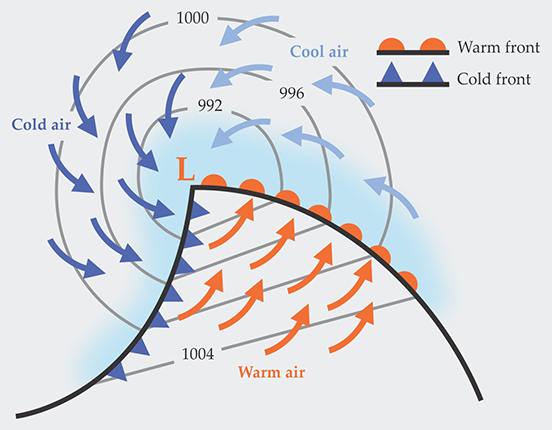
References
1. H. R. Byers, Carl-Gustaf Arvid Rossby, 1898–1957, National Academy of Sciences (1960), p. 247.
2. J. R. Fleming, Inventing Atmospheric Science: Bjerknes, Rossby, Wexler, and the Foundations of Modern Meteorology, MIT Press (2016).
3. C.-G. Rossby, “Planetary flow patterns in the atmosphere,” Q. J. R. Meteorol. Soc. 66(suppl.), 68 (1940).
4. C.-G. Rossby “The Scientific Basis of Modern Meteorology,” in Climate and Man: Yearbook of Agriculture, US Department of Agriculture (1941), p. 599. Reprinted in Handbook of Meteorology, F. A. Berry Jr, E. Bollay, N. R. Beers, eds., McGraw-Hill (1945), p. 501.
5. S. Sörlin, A Tribute to the Memory of Carl-Gustaf Rossby, 1898–1957, Royal Swedish Academy of Engineering Sciences (2015).
More about the Authors
Jim Fleming is the Charles A. Dana Professor of Science, Technology, and Society at Colby College in Waterville, Maine. Parts of this article are drawn from Fleming’s book Inventing Atmospheric Science: Bjerknes, Rossby, Wexler, and the Foundations of Modern Meteorology, published by the MIT Press

